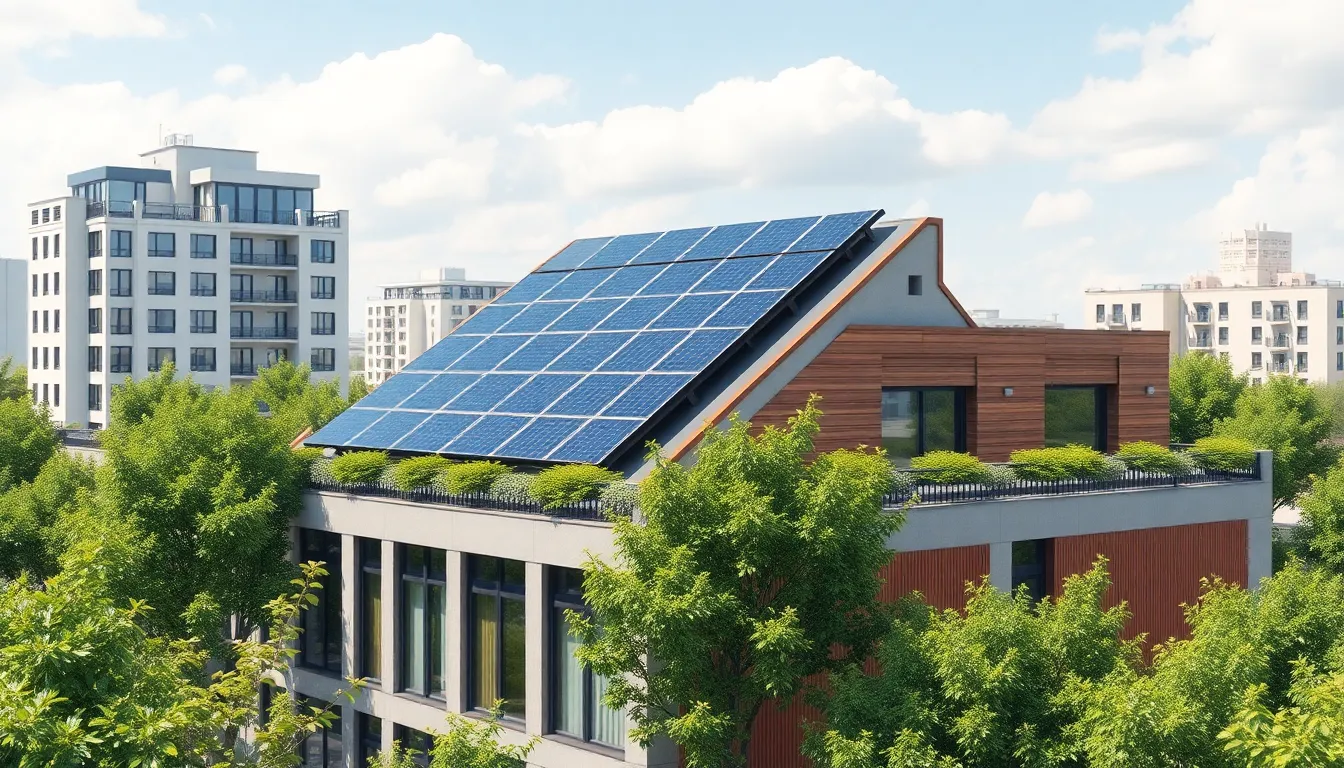In a world where the planet seems to be throwing a tantrum, sustainable building technology emerges as the superhero we didn’t know we needed. Imagine structures that not only shelter us but also hug the Earth with a gentle embrace. From solar panels that soak up the sun like an overzealous beachgoer to materials that recycle themselves faster than you can say “eco-friendly,” this technology is reshaping the way we think about construction.
Gone are the days of buildings that guzzle energy like a frat boy at a keg party. Today’s sustainable designs prioritize efficiency and environmental harmony. They’re not just smart; they’re downright charming. As the industry evolves, it’s clear that embracing sustainability isn’t just a trend—it’s a necessity. So let’s dive into the fascinating world of sustainable building technology and discover how it’s paving the way for a greener future, one brick at a time.
Table of Contents
ToggleOverview Of Sustainable Building Technology
Sustainable building technology encompasses innovative methods and materials that reduce environmental impact during the construction process. Key features include the use of renewable energy sources like solar panels, which significantly lower carbon footprints. Incorporating self-recycling materials aligns with principles of sustainability, serving to minimize waste and encourage circular economies.
Energy efficiency remains a cornerstone of this approach. Buildings designed with optimal insulation and energy-efficient systems can greatly reduce reliance on non-renewable resources. Integrating smart technologies enhances energy management, allowing real-time adjustments that increase efficiency.
Sustainable practices extend beyond materials and technology. Utilizing locally sourced materials decreases transportation emissions, fostering community engagement. Additionally, water conservation solutions, such as rainwater harvesting and greywater recycling systems, further enhance overall sustainability.
Urban planning plays a role in sustainable building technology as well. Creating green spaces within developments promotes biodiversity and improves air quality. Notably, the principles of biophilic design, which connect occupants with nature, contribute to healthier living environments.
Investment in sustainable building technology does not merely offer environmental benefits; it also results in long-term economic advantages. Lower operational costs associated with energy-efficient buildings yield higher returns over time. Shifts in regulatory frameworks continue to support these technologies, promoting eco-friendly construction standards.
This ongoing evolution in sustainable building technology signals a commitment to improving future construction practices. As society progresses, the integration of these features will likely become the standard in building design.
Benefits Of Sustainable Building Technology

Sustainable building technology offers numerous advantages, significantly impacting both the environment and the economy.
Environmental Impact
Sustainable building technology reduces greenhouse gas emissions by incorporating energy-efficient systems. Designs that utilize renewable energy sources, such as solar panels, minimize reliance on fossil fuels. Additionally, materials sourced locally decrease transportation emissions and support regional economies. Efficient insulation in buildings conserves energy, leading to reduced heating and cooling needs. These practices enhance biodiversity and improve air quality, creating healthier environments for occupants.
Economic Advantages
Investment in sustainable building technology yields long-term economic benefits for property owners. Lower operational costs arise from reduced energy consumption and maintenance requirements. Longer-lasting materials decrease the frequency of renovations, providing further savings. Properties built with eco-friendly technologies often attract higher occupancy rates, driving rental income. Regulatory incentives, such as tax breaks and grants, can offset initial investment costs and enhance profitability.
Key Components Of Sustainable Building Technology
Sustainable building technology incorporates essential features that significantly reduce environmental impact. This section explores key components that contribute to greener construction practices.
Energy Efficiency
Energy efficiency ranks among the most critical aspects of sustainable building technology. Implementing smart energy systems optimizes power consumption, lowering overall energy use. Incorporating advanced HVAC systems enables precise climate control while reducing reliance on traditional energy sources. Additionally, utilizing energy-efficient appliances can cut electricity usage by up to 30%. Opting for passive solar design naturally enhances heating and cooling, aligning buildings with environmental harmony. Adoption of LED lighting improves energy performance, drastically reducing energy costs while still maintaining illumination quality.
Sustainable Materials
Sustainable materials significantly impact the overall footprint of construction projects. Using locally sourced resources minimizes transportation emissions, fostering community economies. Choosing sustainably harvested wood promotes forest regeneration and supports biodiversity. Additionally, recycled materials, like reclaimed steel or glass, contribute to resource conservation while reducing waste. Innovative options such as bamboo and rammed earth offer durability and strength with minimal environmental impact. Manufacturers increasingly prioritize eco-friendly certifications, guiding builders in selecting materials that align with sustainability goals.
Water Conservation
Water conservation integrates vital mechanisms that preserve this precious resource in building projects. Implementing rainwater harvesting systems captures natural precipitation for reuse, easing reliance on municipal water supplies. Utilizing low-flow fixtures reduces water consumption by incorporating aerators and dual-flush toilets. Landscape design also plays a crucial role, with drought-resistant plants requiring minimal irrigation. Greywater systems recycle wastewater from sinks and showers for irrigation, further promoting efficient water usage. Employing permeable surfaces helps manage stormwater runoff, enhancing local ecosystems while minimizing flooding risks.
Innovations In Sustainable Building Technology
Innovative approaches in sustainable building technology enhance energy efficiency and reduce environmental footprints. These advancements play a crucial role in creating a greener future.
Smart Building Systems
Smart building systems utilize advanced technology to manage energy use effectively. Sensors monitor occupancy, adjusting lighting and temperature based on real-time data. Automation controls enhance HVAC systems, reducing energy consumption while maintaining comfort. These systems offer predictive maintenance, minimizing downtime and operational costs. Integration of IoT devices allows real-time tracking of resource usage, leading to more informed decision-making for sustainable practices. Ultimately, smart systems contribute to lower utility bills and reduced carbon emissions.
Renewable Energy Integration
Renewable energy integration represents a key innovation in sustainable construction. Solar panels generate clean energy, significantly lowering dependence on fossil fuels. Wind turbines can complement solar systems, providing additional energy sources in suitable locations. Energy storage solutions, such as battery systems, mitigate the intermittent nature of renewable resources, ensuring consistent energy supply. Building design includes features like green roofs to enhance insulation while supporting solar energy systems. Together, these measures enable buildings to operate sustainably, contributing to a significant reduction in energy costs and emissions.
Challenges In Implementing Sustainable Building Technology
Implementing sustainable building technology presents various challenges that stakeholders must navigate effectively.
Cost Barriers
High upfront costs often deter developers from pursuing sustainable construction. Equipment upgrades, such as energy-efficient systems and renewable energy installations, lack immediate affordability for many projects. For instance, solar panel installations can cost thousands upfront, despite long-term savings. Project budgets typically tighten, which leads to compromises on eco-friendly choices. Financial incentives and grants may alleviate this burden, but access remains inconsistent across regions. Promoting awareness of the long-term financial benefits is essential for overcoming this cost barrier.
Regulatory Hurdles
Navigating regulatory landscapes can prove challenging for sustainable building projects. Complex building codes frequently lack updates that reflect rapid advancements in green technology. For instance, outdated zoning laws may restrict the use of modern sustainable features, hampering innovation. Delays in permitting processes often slow down construction timelines and add expenses. Collaboration with regulatory bodies offers potential pathways to revise codes and facilitate eco-friendly designs. Navigating compliance with sustainability standards can also add another layer of complexity.
Sustainable building technology represents a pivotal shift in the construction industry. By embracing innovative materials and energy-efficient systems, developers can create structures that not only meet today’s environmental challenges but also pave the way for a greener future.
As awareness grows around the benefits of these practices, it becomes clear that investing in sustainability is not just a responsible choice but a financially sound one. With ongoing advancements and supportive regulatory frameworks, the path to eco-friendly construction is becoming increasingly viable.
Ultimately, sustainable building technology stands to transform urban landscapes into healthier, more efficient environments that benefit both people and the planet. The commitment to these practices signals a promising future where construction harmonizes with nature.



